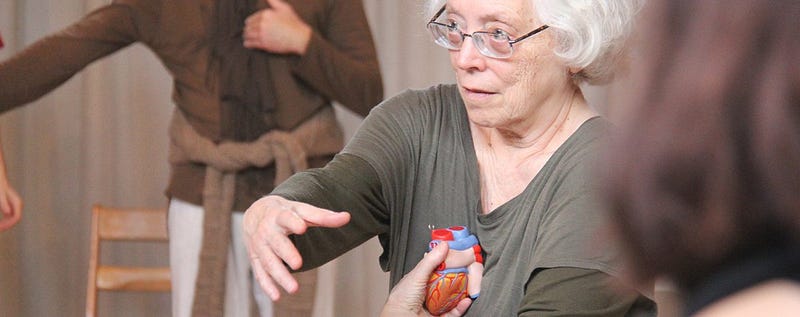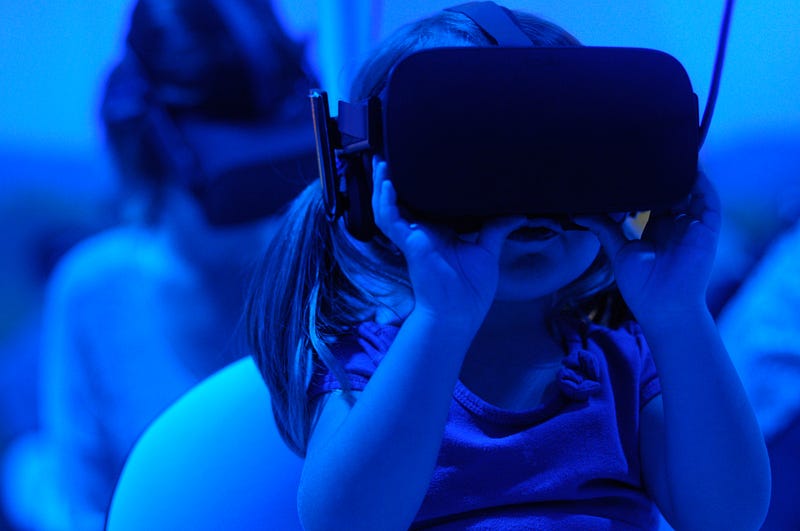 Image
Credit: Megan
Bird
Image
Credit: Megan
BirdTake a deep breath.
We live in anxiety-ridden times. Rapid technological development is far outpacing regulation. Those who should face consequences are often escaping punishment. We’re at the precipice of irreversible climate damage. A gathering storm of public reckoning for long-running oppressions and inequalities is making headlines, yet we are still very much entrenched in these offending systems.
Also, you’re out of hand sanitizer.
If asked, could you describe how your gut feels right now? Can you tell where your breath fills your body — in your chest, your shoulders, your belly? Can you connect a sensation in your body with a recognized emotion? How does your body feel while reading this — and why does this matter for makers of immersive experiences?
Somatics: A brief introduction
Embodiment can be understood as awareness of and through the physical body. From a Western approach, the term “somatic” connotes a similar notion, centering our proprioceptive sense (awareness of the body moving through space) and interoceptive sense (awareness of the body’s internal processes).
Somatic experience operates in a closed feedback loop within our continual process of self-regulation and adaptation, on both physiological and psychological levels. We perceive, and we react, responding to this internal information stream, which operates largely sub-consciously through the nervous system. This first-person bodily experience directly contrasts with a third-person or external observation of another human body. In other words, my own somatic experience cannot be perceived by looking at me, testing or recording my various quantifiable attributes.
Though often subconscious, somatic experience can be cultivated as a function of self-knowledge. The field of “somatics” refers to sensory-motor practices which center this firsthand, bodily understanding. Many have roots in healing therapies, meditation, and/or dance — such as certain styles of yoga, Alexander Technique, Body-Mind Centering, and the Feldenkrais Method. Somatic practices have been instrumental in developing successful trauma therapies as a way to reconnect or process the relationship between cognition and bodily experience.
 Body-Mind
Centering founder, Bonnie Bainbridge Cohen. Image Copyright: Body-Mind Centering
Body-Mind
Centering founder, Bonnie Bainbridge Cohen. Image Copyright: Body-Mind CenteringThe concept of embodied or somatic knowledge can refer to the intelligence and understanding that arises from an experiential, active engagement with our bodies and sensations. We can cultivate this internal knowledge as a way to care for ourselves, be present, and process our experiences. What does embodied knowledge look like in your day-to-day life? What shapes an embodied interaction with a technological device or interface? Embodied knowledge gained through somatic practices may help improve our relationship to technologies that collect and utilize embodied data, through sensing or tracking aspects of our bodies.
Embodied knowledge vs embodied data
Embodied knowledge and embodied data are different ways of conceiving what it means to be human. Look around you now. How many devices can you count in your physical vicinity which sense, detect, or track aspects of the human body? These technologies, whether physically worn or environmentally embedded, are becoming pervasive.
You probably know several people who wear a smartwatch, and alongside text messages and emails, receive notifications that it’s time to “stand up,” or “breathe.” Did you know you can send someone your heartbeat, recorded through this very watch, as a suggested method to stay connected across distance? What about the phone that’s probably in arm’s reach right now, with cute puppy face filters at the ready? What about step counters and sleep tracker apps? Did you notice that new facial recognition kiosk as you boarded your flight at JFK?
Head-worn virtual and augmented reality (AR/VR) devices like the Oculus, Vive, or Hololens, also significantly implicate embodied processes. These devices are worn like ski goggles or glasses, and track your gestures and movements, enabling interaction with virtual objects and environments. Newer devices utilize precise eye-tracking technologies to record exactly what you look at and when. Increasingly accessible (though far from mass adoption), AR/VR headsets are readily depicted in the media, often attached to broad, sweeping claims about the future of work, communication, entertainment, or — (in)famously — empathy.
What all these technologies have in common is that they are fundamentally embodied — they interact with our intertwined physical and cognitive processes as humans. However, this does not mean that any experience or content you encounter will utilize this embodiment in an intuitive, integrated, and positive manner. Even if all the design elements are right, and the experience feels great, the intimate data accessible to these devices and platforms poses a great risk if used unscrupulously.
Private data, personal experiences
Embodied technologies present complex ethical challenges. This spectrum of devices and systems, using algorithms based on statistical prediction, AI, and machine learning, can remind you to exercise, track virtual objects seamlessly with your gestures or eye movements, suggest content, and even read your emotions. Though not all body-sensing devices are recording and keeping the data collected, they can contribute to an enormous (and growing) record of highly personalized and identifiable biometric data across vast populations. Where does all of that information go? Who owns it? Who’s heard of the Biometric Information Privacy Act?
 Image
credit: YO! What Happened
to Peace?
Image
credit: YO! What Happened
to Peace?There are two separate but interrelated issues at hand here. The first concerns how data is being collected and used externally: Significantly, through user agreements, neglecting to alter default privacy settings, and shifting legislative factors, we have lost control of our personal data on a number of levels: biometric data being added to other data collected about individuals through interactions with technology and the internet. This lack of control has serious consequences, which have been articulated in an increasing number of investigative or expository pieces.
The second issue concerns the nature of user experience and the somatic implications of an interaction between an “embodied technology” and an “embodied person.” What happens when user experience is only considered in terms of what can be collected as data points, quantified, and fed into an algorithm, often in service of perpetuating engagement with a product? What happens when the algorithmic prediction made by the technology about you or your embodied experience is wrong?
Is this technology an intuitive extension and augmentation of my body or a shiny tracking device?
Maybe it’s not completely an either/or situation. There is certainly evidence that sensing technologies within consumer products — whether the atrial fibrillation detector on the Apple Watch, or higher-fidelity hand tracking and room detection for VR/AR applications — can create very positive, impactful user experiences. However, recent and growing revelations from certain technology companies, through investigative reports, government testimony, and leaks, are revealing just how deep below the surface this technology continues to operate.
Those qualities which make the experience of embodied technologies better, or at least smoother, more “frictionless” — i.e. biometric sensing, machine learning for recognition, precise location/body/eye-tracking — are the very same qualities that make these devices dangerous when unregulated data collection and ad targeting are the dominant business model of Silicon Valley.
Harvard professor Shoshana Zuboff coined the term “surveillance capitalism” to refer to just this phenomenon. In her 2019 book, The Age of Surveillance Capitalism: The Fight For a Human Future in the New Frontier of Power, she implicates many connected devices and platforms, from networked thermostats to Facebook posts to emerging brain-computer-interfaces (BCI), as contributing to the emergence of a new “natural resource” to be mined and monetized — that of human behavior modification and manipulation.
Incorporated sensors collect data from our bodies which in turn trigger responses from AI systems built on predictive models of behavior. These embodied technologies can alter our interactions with digital and physical scenarios, and in turn, modify our actual behaviors. Only some of these are advertised features of the product. Hidden, covert capabilities of these devices, and lack of data use regulation, have material, harmful consequences driven by profit and power, ranging from users’ hijacked and numbed attention patterns to bias in police and judicial practices.
While more research is needed, I’d posit a possible correlation with a societal distancing and devaluation of embodied experience. So many aspects of our lives, all day every day, are filtered through computational systems and designed “user experiences.” We slip between digital and physical identities, performing ourselves, making transactions, moving from one place to another, and receiving feedback in the form of quantifiable data, likes, and statistics. In these terms, what does “experience” really mean, and how does this translate to our interactions with the world around us? What do body-sensing technologies aimed at consumers do for us, and where do they fall short?
It is not difficult to sense an ebbing of human agency to make choices and utilize our embodied knowledge in the face of a multiplicity of technological “solutions.” While body-worn, sensing devices, and corresponding content can be designed to enable powerful, entertaining, informative experiences, they also may trigger or encourage disembodied, numbed, or distressing experiences. Additionally, these technologies collect and utilize highly intimate, personal information about us, and pose challenges to our autonomy.
We have a responsibility to question how we work with embodied devices and data, especially those which lay claim to our construction of “reality” through AR/VR. Jenny Odell, in her recent book, How to Do Nothing: Resisting the Attention Economy, poses the well-articulated question: “What does it mean to construct digital worlds while the actual world is crumbling before our eyes?” As creators and developers, engineers and authors, how do we negotiate this reality, tell human stories, and enable positive embodied interactions through these algorithmic systems?
 Photo by Giu
Vicente on Unsplash
Photo by Giu
Vicente on Unsplash
The way I think, feel, and interact has been deeply affected by my experience with movement, dance, and yoga practitioners. Through artistic and research collaboration, and as a student, I have determined that the embodied and somatic knowledge these practitioners engage in has crucial lessons to teach not only general users but the very developers and designers of hardware, software, and content for “embodied technologies.”
Somatic understanding may help us re-situate our bodily agency within our whole selves, bring awareness to consent, and re-frame our relationship to user experiences in which our behavior, body, or identity is manipulated through computational systems. We may then be able to evaluate their use to us more clearly, defining what we want and don’t want out of them, rather than submitting to a system which numbs, harms, and uses us like livestock in an effort to generate wealth and power for a select few.
In my next piece, I will speak with a collaborator and teacher who makes embodiment her life’s work.
Immerse is an initiative of the MIT Open DocLab and The Fledgling Fund, and it receives funding from Just Films | Ford Foundation and the MacArthur Foundation. IFP is our fiscal sponsor. Learn more here. We are committed to exploring and showcasing media projects that push the boundaries of media and tackle issues of social justice — and rely on friends like you to sustain ourselves and grow. Join us by making a gift today.